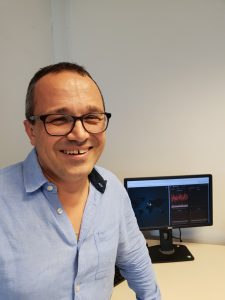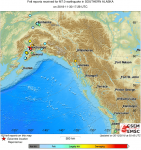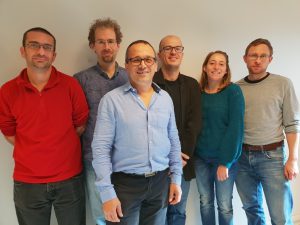On 30 November 2018, users of the LastQuake app received notifications on their phones and computers—an M7.0 earthquake had just struck Alaska.
Upon clicking the notification, they were taken to a page with maps, data and comments from those who felt the quake. Within seconds, they knew exactly where and how strong it was. Within the hour, they saw user-uploaded photographs showing the extent of the damage.

Closely monitoring how well the app functioned was Rémy Bossu, Secretary General of the European-Mediterranean Seismological Centre (EMSC) and the app’s co-creator.
Finding new ways to rapidly collect and communicate earthquake information is a major part of Bossu’s job. He starts each morning by checking in on the latest earthquakes around the world and seeing how EMSC’s systems have performed. He also checks social media to see what the public response to those earthquakes has been.
“Twitter is always open,” he says. “It’s a very efficient tool to share scientific information.”
After the 5 August 2018 earthquake sequence in Lombok, Indonesia, for example, Bossu used the social media platform to answer questions from tourists in the region who couldn’t find authoritative information in English.
“Even if we couldn’t answer every question about the sequence, our efforts were greatly appreciated and eyewitnesses told us it helped reduce their anxiety,” he says.
“Involving citizens and eyewitnesses is the best way to develop trust and contribute to improved awareness and better preparation.”
While this work keeps him in the office most days, it was a “love for traveling, nature and discovering other cultures” that brought Bossu to seismology in the first place.
“In the early 90s, I was studying physics at the University of Grenoble,” he recalls. “I came across a master topic on induced seismicity in Uzbekistan, including field work. I signed up and have never regretted it!”
Bossu went on to receive his Ph.D. in seismology at Grenoble, with an emphasis on induced seismicity (earthquakes caused by human activities) and seismic hazard assessment, and began working as a seismologist. But his interest in crowdsourced data began evolving in 2004, two years after joining EMSC.
He noticed that EMSC’s website would crash due to high traffic immediately after major earthquakes and realized it was a “measurement of the public’s desire for information.”
Bossu and his colleagues began working on ways to use the influx of website traffic productively. They discovered that the geographical origin of IP addresses trying to access their website could provide an approximate location of an earthquake.

“It was the first crowdsourced earthquake detection,” Bossu says. “It was the beginning of our research and we gradually developed it to integrate social networks and smartphone apps.”
LastQuake, EMSC’s primary app, was born from this project ten years later.
“We had a project with the Fondation MAIF, a French insurance company, to raise public awareness on seismic hazard through dedicated webpages,” says Bossu. “When we presented our plan, we were asked to switch from webpages to a smartphone app. We came back a few weeks later with the idea of LastQuake.”
Along with user-uploaded photos of damage or reports of how strong the shaking felt, the app has also grown to provide actions to take once the shaking stops.
“We performed an online survey of our users from Nepal after the 2015 Gorkha earthquake,” says Bossu. “Their main request was ‘tell us what we should do after an earthquake,’ which led to the integration of visual safety tips and safety check mechanisms.”
Utilizing social media and smartphone apps to raise awareness and develop earthquake preparation is now one of EMSC’s central goals. Bossu works with a diverse team of seismologists, software developers, physicists and even a sociologist who helps them understand how users interact with their apps.

Apps, however, are only one side of what EMSC does.
“LastQuake is definitely our most visible activity at the moment,” says Bossu, “but we also provide data access for the seismological community under the framework of the European Plate Observing System.”
Outside their headquarters, EMSC collaborates and exchanges data with approximately 80 institutions, including a close relationship with the National Earthquake Information Center and U.S. Geological Survey. EMSC is also a part of the ARISTOTLE project, which provides 24/7 expert support and advice to the EU Civil Protection Mechanism’s Emergency Response Coordination Center.
Earthquake data isn’t all that Bossu works on. As Secretary General, he performs administrative tasks (“many emails!” he jokes), interfaces with members and fundraises.
“One of the biggest challenges is the lack of permanent funding,” he says. “It means we have to look at any funding opportunities to implement the developments we have in mind, or adapt our goals to match a specific call for proposals.”
“…apps don’t compete with websites, social networks, TV or radio, but they complete them.”
Looking forward, Bossu is excited about developing new projects. One such project is a collaboration with Francesco Finazzi, a statistician at the University of Bergamo in Italy, whose EarthquakeNetwork app uses accelerometers inside smartphones to detect earthquakes.
While these apps play a key part in alerting and informing the public, however, Bossu warns they’re “not the silver bullet.”
“In terms of reach, apps don’t compete with websites, social networks, TV or radio, but they complete them,” he says. “An app can only be a part of a multichannel information system.”
In the long run, he envisions a one-stop-shop type of app that has detailed notifications for each kind of national emergency. Until then, however, he continues to focus on EMSC’s own products.
“I’d like to convince the seismological community that crowdsourced data can improve observational seismology,” he says. “Involving citizens and eyewitnesses is the best way to develop trust and contribute to improved awareness and better preparation.”
SSA At Work is a monthly column that follows the careers of SSA members. For the full list of issues, head to our At Work page.
